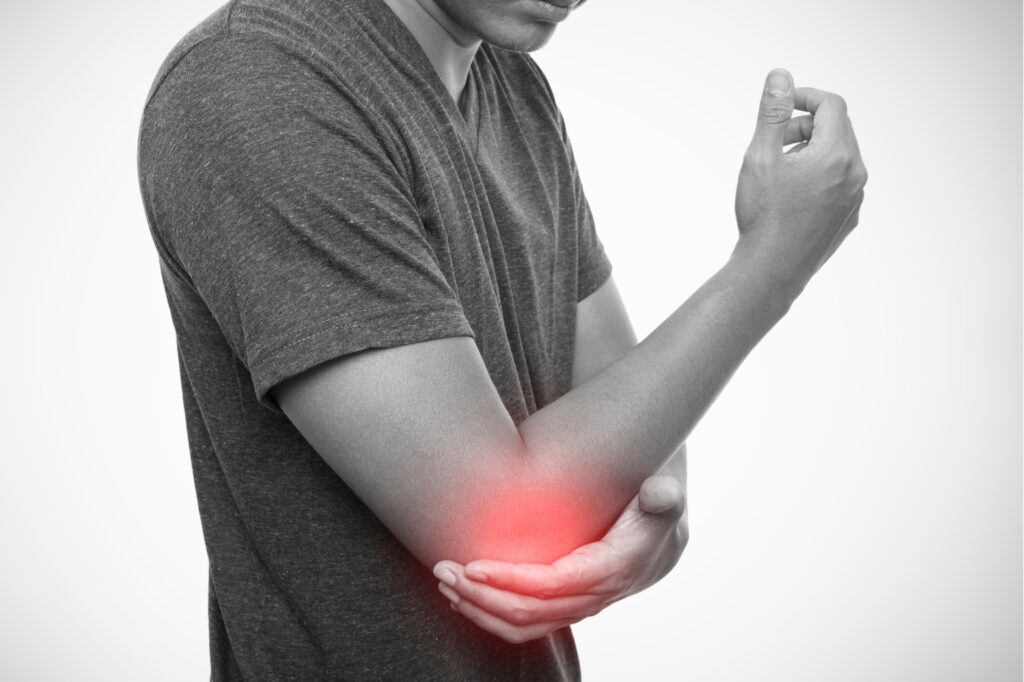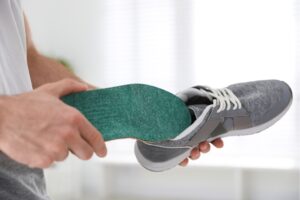Elbow pain is a common complaint that can significantly impact daily life and activities. Whether it’s sharp, shooting pain or a dull ache, elbow pain can limit our ability to do simple tasks like lifting objects, typing, or even enjoying a game of tennis. In order to effectively treat elbow pain, it’s important to understand the causes and treatment options available.

Understanding the Causes of Elbow Pain
Elbow pain can have several causes, ranging from repetitive movements to conditions like arthritis and tendonitis. Some common causes of elbow pain include:
- Tennis elbow: This condition, also known as lateral epicondylitis, occurs when the tendons on the outside of the elbow become inflamed and irritated due to repetitive wrist movements. Activities like playing tennis, typing, and even knitting can contribute to tennis elbow.
- Golfer’s elbow: Also known as medial epicondylitis, golfer’s elbow affects the tendons on the inside of the elbow. It is caused by repetitive movements and can occur in golfers, but also in individuals who engage in activities that involve gripping or repetitive forearm movements.
Tennis Elbow: A Common Cause of Elbow Pain
Tennis elbow, or lateral epicondylitis, is a common cause of elbow pain. Despite its name, tennis elbow can affect individuals who are not tennis players. The condition develops when the tendons on the outside of the elbow become strained and damaged due to repetitive wrist movements.
Activities that frequently involve these repetitive movements, such as painting, gardening, or using a computer mouse, can lead to the development of tennis elbow. The pain typically radiates from the outside of the elbow and can extend down the forearm.
Early diagnosis and treatment of tennis elbow are vital for preventing more severe cases. Rest, avoiding repetitive movements, and applying ice or heat to the affected area can provide temporary relief. Physiotherapy and exercises, such as eccentric exercises for pain relief, that target the forearm muscles and tendons can also aid in the recovery and reduce tennis elbow pain and inflammation. Understanding the causes and treatment options for tennis elbow can help individuals manage the condition effectively and prevent further damage.
Golfer’s Elbow: Another Frequent Cause of Elbow Pain
Golfer’s elbow, or medial epicondylitis, is another common cause of elbow pain. This condition affects the tendons on the inside of the elbow and is often caused by repetitive movements and gripping activities. Despite its name, golfer’s elbow can affect individuals who do not play golf.
Individuals who engage in activities such as golf, weightlifting, or repetitive forearm movements are at a higher risk of developing golfer’s elbow, also known as medial epicondylitis. The pain typically radiates from the inside of the elbow and can extend to the wrist and hand. In severe cases, individuals may experience loss of grip strength and difficulty performing everyday tasks.
Treatment options for golfer’s elbow range from physiotherapy to surgery, depending on the severity of the condition. Physiotherapy can help strengthen the forearm muscles and relieve pain, while steroid injections and pain management techniques may also be used. Understanding the causes and treatment options for golfer’s elbow is essential for effective management and recovery.
Treating Elbow Disorders
Treating elbow pain and disorders involves addressing the underlying causes and managing the pain and inflammation. The treatment options for elbow pain can vary depending on the severity of the condition and the individual’s specific needs.
Non-Surgical Treatment Options for Elbow Pain
Non-surgical treatment options are often the first line of defense for elbow pain and can provide effective pain relief and restoration of function. Some non-surgical treatment options for elbow pain include:
- Physiotherapy: Physiotherapy exercises and techniques can help strengthen the injured tendons and muscles, improve range of motion, and reduce pain and inflammation.
- Rest and modified activities: Rest and avoiding activities that cause pain or repetitive strain on the elbow joint can help promote healing and prevent further damage.
- Pain relief measures: Over-the-counter pain medications, such as non-steroidal anti-inflammatory drugs (Advil, Motrin), can provide temporary relief from elbow pain and reduce inflammation.
- It’s important to consult with a healthcare provider to understand and determine the most appropriate treatment options for your specific elbow pain condition. They can assess your medical history, physical exam, and may recommend imaging tests, such as an X-ray or magnetic resonance imaging (MRI), to accurately diagnose the underlying cause of your elbow pain and develop an individualized treatment plan.
How Our Clinic Can Help
Etobicoke High Performance Health Clinic is dedicated to providing specialized care for individuals experiencing elbow pain. We understand the impact that elbow pain can have on daily life and activities, and our healthcare providers are committed to accurate diagnosis and effective treatment options.
Specialized Care for Elbow Pain at Our Clinic
At Etobicoke High Performance Health Clinic, we offer specialized care for tennis elbow, golfer’s elbow, and other elbow disorders. When you visit our clinic, our healthcare providers will take a comprehensive medical history and perform a thorough physical exam to accurately diagnose the underlying cause of your elbow pain. This allows us to develop a tailored treatment plan that addresses your specific needs and condition.
Our clinic is equipped with advanced diagnostic tools and medical expertise, ensuring that you receive accurate and timely diagnosis and treatment options. We prioritize patient education and involvement in the treatment process, empowering you with the knowledge and tools to actively participate in your recovery and long-term elbow health.
Here at EHP Clinic, we are equipped with a diverse array of technologies that will assist in the treatment process. Some of these include shockwave therapy, Summus class IV therapy laser, acupuncture therapy, electrotherapy, and active release therapy. Our team of professionals including chiropractors, physiotherapists, massage therapists and a kinesiologist / personal trainer are committed to working together to provide the best treatment for you.
Book an appointment:https://etobicokehighperformancehealth.janeapp.com/
What are the causes of elbow tendonitis?
The main causes of elbow tendonitis are repetitive motions, such as those involved in sports or certain occupations, and overuse of the elbow joint. It can also be caused by age-related degeneration of the tendon or a sudden injury.
Preventing Future Elbow Pain
Preventing future elbow pain involves making certain lifestyle changes and incorporating exercises and practices that promote elbow joint health.
Exercises to Strengthen Your Elbow
- Specific exercises targeting the forearm muscles, such as wrist curls and forearm pronation and supination, can help strengthen the elbow joint and prevent strain and injury.
- Including regular physical activity and exercises that focus on the arm muscles and flexibility can improve blood flow, promote joint health, and reduce the risk of elbow pain.
- Incorporating resistance training, such as using dumbbells or resistance bands, can enhance stability and strength in the arm muscles.
- Flexibility exercises, such as stretching the wrist and forearm muscles, can help maintain proper range of motion and prevent stiffness and pain.
- By regularly incorporating these exercises into your routine and maintaining physical activity levels, you can strengthen the arm muscles, protect the elbow joint, and reduce the risk of future elbow pain.
Lifestyle Changes to Prevent Elbow Pain
In addition to exercises, making certain lifestyle changes can also help prevent elbow pain and injury:
- Avoid repetitive movements that strain the elbow joint, and take breaks during activities that require repetitive elbow movements.
- Practice proper techniques and form when lifting heavy objects or performing strenuous tasks to minimize the risk of elbow injury.
- Maintain a healthy body weight to reduce stress on the elbow joint and minimize the risk of joint pain and inflammation.
- Stay hydrated to ensure proper blood flow and optimal function of the arm muscles and joints.
- Listen to your body and take rest days when necessary, allowing your muscles and joints to recover and prevent overuse injuries.
- By making these lifestyle changes and incorporating preventive measures, individuals can reduce the risk of elbow pain and maintain optimal elbow joint health.
Frequently Asked Questions
What are some non-surgical treatment options for elbow pain?
Non-surgical treatment options for elbow pain include:
- Rest and avoiding activities that cause pain and strain on the elbow joint.
- Physiotherapy exercises and techniques to strengthen the muscles and improve range of motion.
- Over-the-counter pain medications, such as Advil or Motrin, for temporary relief.
- Electrotherapy, laser therapy, acupuncture are all effective and provided here at EHP clinic!
How can I prevent future elbow injuries and pain?
To prevent future elbow injuries and pain, always warm up before physical activity, use proper technique when lifting heavy objects, take breaks and stretch during repetitive movements, and consider using protective gear.
Conclusion
In conclusion, understanding the causes of elbow pain is crucial for effective treatment and prevention. Whether it’s tennis elbow or golfer’s elbow, identifying the specific condition allows for targeted therapies and rehabilitation exercises. Non-surgical treatment options such as physical therapy, medication, and wearing braces can alleviate pain and promote healing. It’s important to follow post-treatment care instructions to ensure a successful recovery. Our clinic specializes in providing comprehensive care for elbow pain, offering specialized treatments tailored to individual needs. However, preventing future elbow pain is just as important. Incorporating exercises to strengthen the elbow and making lifestyle changes to avoid repetitive stress can help maintain elbow health in the long run. If you have any further questions or concerns, please don’t hesitate to reach out or visit us at our clinic!
References
Department of Health & Human Services. (2003, April 14). Elbow pain. Better Health Channel. https://www.betterhealth.vic.gov.au/health/conditionsandtreatments/elbow-pain
Mayo Foundation for Medical Education and Research. (2023, April 29). Elbow pain causes. Mayo Clinic. https://www.mayoclinic.org/symptoms/elbow-pain/basics/causes/sym-20050874
While You’re Here…
Browse Services Available at EHP here: https://www.etobicokehealthclinic.com/services/
Check Out the Products we Carry In-Clinic and Online: https://www.etobicokehealthclinic.com/products/
Get To Know Our Staff: https://www.etobicokehealthclinic.com/practitioners/
Take a Look at Our Current Promotions: https://www.etobicokehealthclinic.com/promotions/
Read More Blogs From Us Here: https://www.etobicokehealthclinic.com/blog/
Book an Appointment Now: https://etobicokehighperformancehealth.janeapp.com/
Contact Us Here: https://www.etobicokehealthclinic.com/contact/ Follow Us on Instagram: https://www.instagram.com/ehpclinic/


